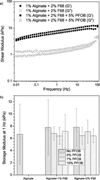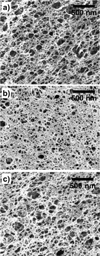Addition of perfluorocarbons to alginate hydrogels significantly impacts molecular transport and fracture stress
- PMID: 22865503
- PMCID: PMC5084458
- DOI: 10.1002/jbm.a.34344
Addition of perfluorocarbons to alginate hydrogels significantly impacts molecular transport and fracture stress
Abstract
Perfluorocarbons (PFCs) are used in biomaterial formulations to increase oxygen (O(2) ) tension and create a homogeneous O(2) environment in three-dimensional tissue constructs. It is unclear how PFCs affect mechanical and transport properties of the scaffold, which are critical for robustness, intracellular signaling, protein transport, and overall device efficacy. In this study, we investigate composite alginate hydrogels containing a perfluorooctyl bromide (PFOB) emulsion stabilized with Pluronic(®) F68 (F68). We demonstrate that PFC addition significantly affects biomaterial properties and performance. Solution and hydrogel mechanical properties and transport of representative hydrophilic (riboflavin), hydrophobic (methyl and ethyl paraben), and protein (bovine serum albumin, BSA) solutes were compared in alginate/F68 composite hydrogels with or without PFOB. Our results indicate that mechanical properties of the alginate/F68/PFOB hydrogels are not significantly affected under small strains, but a significant decrease fracture stress is observed. The effective diffusivity D(eff) of hydrophobic small molecules decreases with PFOB emulsion addition, yet the D(eff) of hydrophilic small molecules remained unaffected. For BSA, the D(eff) increased and the loading capacity decreased with PFOB emulsion addition. Thus, a trade-off between the desired increased O(2) supply provided by PFCs and the mechanical weakening and change in transport of cellular signals must be carefully considered in the design of biomaterials containing PFCs.
Copyright © 2012 Wiley Periodicals, Inc.
Figures






Similar articles
-
Transport of biological molecules in surfactant-alginate composite hydrogels.Acta Biomater. 2011 Nov;7(11):3988-98. doi: 10.1016/j.actbio.2011.07.009. Epub 2011 Jul 14. Acta Biomater. 2011. PMID: 21798381 Free PMC article.
-
Hydrogel-perfluorocarbon composite scaffold promotes oxygen transport to immobilized cells.Biotechnol Prog. 2008 Mar-Apr;24(2):358-66. doi: 10.1021/bp070160f. Epub 2008 Feb 23. Biotechnol Prog. 2008. PMID: 18293995
-
A novel pH-sensitive hydrogel composed of N,O-carboxymethyl chitosan and alginate cross-linked by genipin for protein drug delivery.J Control Release. 2004 Apr 28;96(2):285-300. doi: 10.1016/j.jconrel.2004.02.002. J Control Release. 2004. PMID: 15081219
-
Alginate based hydrogel as a potential biopolymeric carrier for drug delivery and cell delivery systems: present status and applications.Curr Drug Deliv. 2012 Nov;9(6):539-55. doi: 10.2174/156720112803529800. Curr Drug Deliv. 2012. PMID: 22998675 Review.
-
Oil encapsulation techniques using alginate as encapsulating agent: applications and drawbacks.J Microencapsul. 2017 Dec;34(8):754-771. doi: 10.1080/02652048.2017.1403495. Epub 2017 Nov 21. J Microencapsul. 2017. PMID: 29161939 Review.
Cited by
-
Optimization of Oxygen Delivery Within Hydrogels.J Biomech Eng. 2021 Oct 1;143(10):101004. doi: 10.1115/1.4051119. J Biomech Eng. 2021. PMID: 33973004 Free PMC article. Review.
-
Design of Thermoresponsive Polyamine Cross-Linked Perfluoropolyether Hydrogels for Imaging and Delivery Applications.ACS Med Chem Lett. 2020 Aug 11;11(10):2032-2040. doi: 10.1021/acsmedchemlett.0c00198. eCollection 2020 Oct 8. ACS Med Chem Lett. 2020. PMID: 33062189 Free PMC article.
-
Terminal sterilization of alginate hydrogels: efficacy and impact on mechanical properties.J Biomed Mater Res B Appl Biomater. 2014 May;102(4):877-84. doi: 10.1002/jbm.b.33070. Epub 2013 Nov 21. J Biomed Mater Res B Appl Biomater. 2014. PMID: 24259507 Free PMC article.
-
An Injectable Oxygen Release System to Augment Cell Survival and Promote Cardiac Repair Following Myocardial Infarction.Sci Rep. 2018 Jan 22;8(1):1371. doi: 10.1038/s41598-018-19906-w. Sci Rep. 2018. PMID: 29358595 Free PMC article.
-
High oxygen preservation hydrogels to augment cell survival under hypoxic condition.Acta Biomater. 2020 Mar 15;105:56-67. doi: 10.1016/j.actbio.2020.01.017. Epub 2020 Jan 15. Acta Biomater. 2020. PMID: 31954189 Free PMC article.
References
-
- Stoppel WL, Roberts SC. Oxygen Supply for Tissue Engineering. In: Bhatia SK, editor. Engineering Biomaterials for Regenerative Medicine. Springer New York: 2012. pp. 41–86.
-
- Leslie-Barbick JE, Saik JE, Gould DJ, Dickinson ME, West JL. The promotion of microvasculature formation in poly(ethylene glycol) diacrylate hydrogels by an immobilized VEGF-mimetic peptide. Biomaterials. 2011;32(25):5782–5789. - PubMed
-
- Silva EA, Mooney DJ. Spatiotemporal control of vascular endothelial growth factor delivery from injectable hydrogels enhances angiogenesis. Journal of Thrombosis and Haemostasis. 2007;5(3):590–598. - PubMed
-
- Chin K, Khattak SF, Bhatia SR, Roberts SC. Hydrogel-perfluorocarbon composite scaffold promotes oxygen transport to immobilized cells. Biotechnology Progress. 2008;24(2):358–366. - PubMed
-
- Kimelman-Bleich N, Pelled G, Sheyn D, Kallai I, Zilberman Y, Mizrahi O, Tal Y, Tawackoli W, Gazit Z, Gazit D. The use of a synthetic oxygen carrier-enriched hydrogel to enhance mesenchymal stem cell-based bone formation in vivo. Biomaterials. 2009;30(27):4639–4648. - PubMed
Publication types
MeSH terms
Substances
Grants and funding
LinkOut - more resources
Full Text Sources
Other Literature Sources
Miscellaneous

